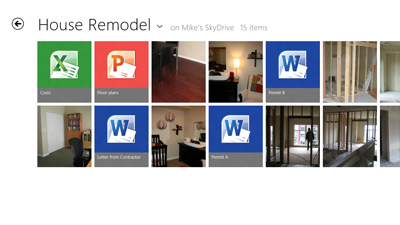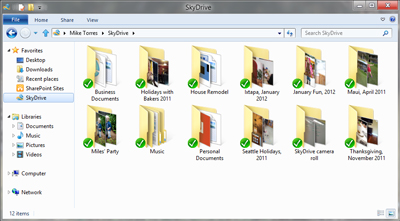News
Microsoft Details Major SkyDrive Changes, Preps Metro App for Windows 8
- By Gladys Rama
- February 21, 2012
A SkyDrive storage app optimized for Windows 8's "Metro"-style user interface will debut with the Windows 8 consumer preview release, Microsoft said this week.
In a "Building Windows 8" blog post on Monday, SkyDrive Group Program Managers Omar Shahine and Mike Torres detailed three major changes coming to the cloud-based file storage and sharing system. The first is the Metro-style app for Windows 8 that will be included in the consumer preview expected on Feb. 29. The second is a "desktop" app that will run on Windows 8, Windows 7 and Windows Vista. The third major change is a new "fetching" feature that will give SkyDrive.com users access to files on their remote PCs.
The overarching goal driving these changes, they wrote, is to elevate SkyDrive beyond just a file-sharing Web site and into a "true device cloud for Windows customers."
SkyDrive on Windows 8
The Metro-style SkyDrive app for the forthcoming Windows 8 OS will represent a merging of sorts of SkyDrive and Windows Live Mesh, Microsoft's Web-based synchronization service, Shahine and Torres wrote. The app will also work on Windows 8 on ARM devices.
"With the SkyDrive app, an early version of which will be available at Consumer Preview, we focused on two things: 1) designing a fast, fluid, touch-first version of SkyDrive that makes it quick, easy, and even fun to browse and access your files, and 2) making your SkyDrive available for use from any Metro style app via the file picker (open/save) and the new Share charm in Windows 8," they said.
In a video accompanying the blog (.MP4), Shahine and Torres demonstrated how the SkyDrive app will look and work on Windows 8. The app shows all of the user's documents and photos, including photos that were automatically uploaded from the user's Windows Phone photo library. To demonstrate how SkyDrive integrates with other apps, Torres opened a photo from SkyDrive in a photo-editing program. He then edited the photo and saved the new version back in SkyDrive. Afterward, using "SkyDrive picker," he was able to open SkyDrive, navigate to the edited picture and use that image as his new lock-screen photo.

[Click on image for larger view.] |
| The Metro-style SkyDrive app on Windows 8. |
The big takeaway is the ability to open, edit and save SkyDrive files from any app, just as users would be able to access files on the local hard drive. Conversely, any apps that include open-and-save functionality will also automatically support SkyDrive "without adding a single line of code," Shahine and Torres said.
"This will work with any app that supports open and save for documents and photos, and will be the first time anything like this has been possible without any setup or configuration," they wrote.
Eventually, Microsoft says, the SkyDrive app will adopt most of SkyDrive.com's functionality, "so there won't be a question of which experience someone should use."
Desktop SkyDrive App
In addition to the Metro-style Windows 8 app, Microsoft also plans to deliver a desktop app that can be managed through Windows Explorer and using Windows 8's file-management features. The desktop app will allow for quick drag-and-drop file uploading. Any edits made to a file in the SkyDrive desktop app will automatically sync to SkyDrive.com as well as the user's connected devices.
"Anything I can do with Explorer, I can do with my SkyDrive files," Torres said in the demonstration video. "There are no compromises."

[Click on image for larger view.] |
| The SkyDrive folder in Windows Explorer. |
The app's installation will take only seconds and needs to be done just once per PC, according to Shahine and Torres. SkyDrive will then begin syncing with any folder the user chooses.
"As you update files on your PC, they're uploaded immediately to the cloud -- and as changes are made in the cloud or on another device, they'll sync back down to the PC," the blog said. "There's very little to manage or control and you won't be bugged with pop-ups or dialog boxes. You won't even need to know it's running, as we've also spent a lot of time on network efficiency and overall performance."
The desktop SkyDrive app will run on Windows 7 and Vista, in addition to Windows 8. According to the blog, the app will support file uploads as large as 2 GB and will allow users to sync "up to [their] available quota of storage (and the ability to unlock more)," which seems to hint at a for-pay storage option. Currently, SkyDrive users get up to 25 GB of file storage space for free. According to allegedly leaked slides posted to the site Gemind.com.br this weekend, Microsoft is planning to offer additional SkyDrive storage ranging from 20 GB for $10 per year to 100 GB for $50 per year. However, Microsoft has not commented on such a plan.
The company also has not revealed when the desktop app will become available.
'Fetching'
The third and final feature discussed in the blog is "fetching," or what Microsoft calls internally the "Forget something?" feature. Essentially, users on SkyDrive.com can use the fetching feature to access un-synced files in their remote SkyDrive-connected computers. The feature was designed for users who will not move all of their files from their PCs to SkyDrive. These users may sometimes forget to add a file to their SkyDrive accounts, but the fetching feature will allow them to access those files remotely.
To safeguard against unwanted PC access, fetching will work only after the user types in a security code that is sent to their phone or a secondary e-mail address. "Two-factor authentication is required before you can connect remotely," the blog said.
Microsoft did not say when the fetching feature will be rolled out.